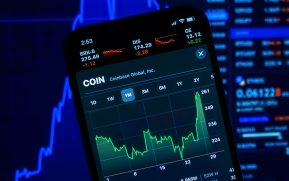
No matter what type of crypto trader you are, you need knowledge on crucial topics like risk. When you understand risk, you can understand the market better and build your trading plan and vision from this knowledge. If you’re too much of a risk-taker, you’ll be unable to prevent your positions from getting liquidated.
If you’re too risk-averse, you’ll be unable to grow your trading account at an optimal pace. One way to go about proper risk management is to understand how much risk you’re taking relative to your reward. A trader checking the value of a coin like the Mina Protocol price would have to base a trade on the potential downside and upside.
When you do this, you’re essentially performing an analysis of your risk-reward levels. Below, you’ll see how you can calculate risk/reward ratios before you get into trading positions.
The risk/reward ratio is used to evaluate how much risk you’re taking in a crypto trading position with reward. You get to calculate the amount of money you’ll earn for every $1 you can potentially lose.
Calculating the risk/reward ratio is not a complicated task. You simply divide the risk on your trading position by the potential reward you want to make. You can start by checking the price of the coin you want to trade. After that, you’ll have to determine where your stop-loss and take-profit levels would be.
Setting stop-loss and take-profit levels are vital for managing risk on trades. It’s good practice to determine where to close a trading position if you’re winning or losing before locking in the trade. Once you have your entry and exit targets, you can calculate your risk/reward ratio. All you need to do is divide the risk by your reward.
Let’s take an instance where your technical analysis forecasts that bitcoin’s price will rise. During your analysis, your figures show that your take-profit level should be 15% of your entry price. Your research also shows that if bitcoin’s value moves 5% below your entry price, then your forecast was wrong.
You should note that take-profit and stop-loss levels shouldn’t be random and entirely based on your analysis. You can use price action techniques or technical indicators to this effect.
Hence, the maximum loss you can make from this trade is 5% of your trading position. The maximum possible gain from this trade is also 15%. To get your risk/reward ratio, we divide five by 15, which is 1/3. In essence, your risk/reward ratio for this trade is 1:3.
In layperson’s terms, it means for every $1 you risk on the trade, you’re potentially winning three times the reward, which is $3. If you’re trading $1,000 on that specific trade, if you risk $50, your potential reward would be $150.
In the crypto trading space, a risk/reward ratio of 1:3 is great for a particular trading setup. If your risk-reward ratio is higher, like 1:1, depending on your win ratio, it might not be beneficial to take the trade since, theoretically, you’d only have to win 50% of your trades to break even.
A way traders evaluate how well their strategies will perform is to use risk-reward ratios with the win rates. You need to divide your wins by your total trades and take the percentage to get your win rate. For instance, if you win 6 out of every ten trades, your win rate is 6/10 * 100. This means your win percentage is 60%.
To use risk-reward ratios in conjunction with win rates, you can evaluate how much you theoretically stand to make or lose after a series of trades. If your win rate on a particular coin is 50% and your trading plan includes a minimum risk-reward ratio of 1:2, this means you’ll risk $1 for every potential $2 reward you stand to gain.
Hence, if you win 5 out of 10 trades, you’ll potentially stand to lose $5 in total and gain $10 in return. This means you can make an aggregate profit of $5, which is good for your trading balance. If your win rate is reduced to 40% with the same risk/reward ratio of 1:2, you stand to make $8 from 4 trades won and lose $6 from the six trades lost.
In this case, you’d still make a net profit of $2. In essence, risk/reward ratios in financial management show that you can lose more than half of your trades and still be in profit.
Nevertheless, a win rate of 30% with a risk-reward ratio of 1:2 places you in a losing position since you’d make $6 from the three winning trades and lose $7 from the seven lost trades. This means you’d be on an aggregate loss of $1.
By checking your historical wins and losses and calculating your win ratio, you can use this information to set your risk-reward ratio. Nevertheless, you need to understand that while the past is the best predictor of the future, things may not go according to plan, and you may have to adjust these ratios.
Understanding proper risk management as a crypto trader is one of the most crucial aspects of trading the market. Risk-reward ratios can be calculated by dividing your potential risk by your potential reward. To get the best out of your trading, you need to determine your historical win percentage to calculate your risk/reward ratio.
India CSR is the largest media on CSR and sustainability offering diverse content across multisectoral issues on business responsibility. It covers Sustainable Development, Corporate Social Responsibility (CSR), Sustainability, and related issues in India. Founded in 2009, the organisation aspires to become a globally admired media that offers valuable information to its readers through responsible reporting.
Water’ being one of the focus area for Tata group, we started with a small water conservation project in 2017…
Copyright © 2022 – India CSR | All Rights Reserved
Copyright © 2022 – India CSR | All Rights Reserved
 How To Make Huge Profits In A Short Time With Crypto
How To Make Huge Profits In A Short Time With CryptoGet detailed training system that shows an absolute beginner (without any skill) how to make huge profits in a short time with crypto.
 Crypto + NFT Quick Start Course
Crypto + NFT Quick Start CourseThe #1 course for profit in the Crypto & NFT world - You will discover the secrets that 99% of people don’t know yet





